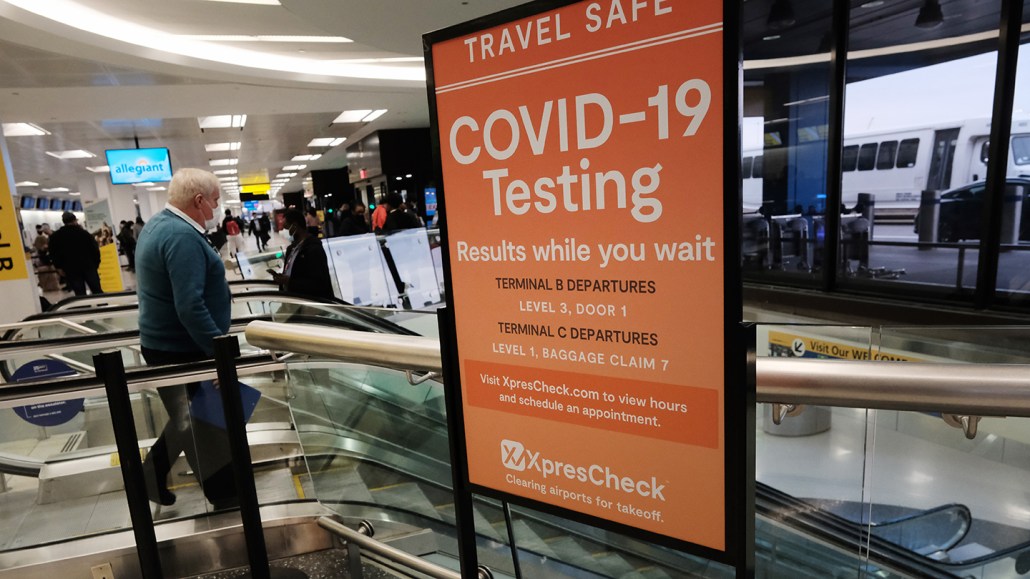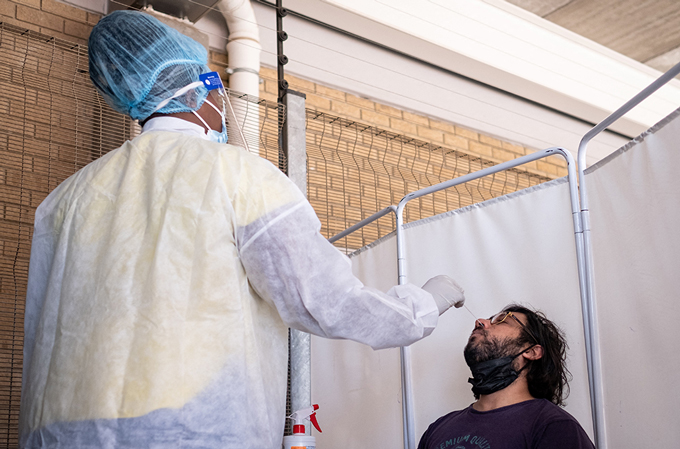What we know and don’t know about the omicron coronavirus variant
Guesses about the new variant abound, but only time will tell if it can compete with delta

After researchers in South Africa and Botswana identified the omicron variant in late November, U.S. health officials have begun ramping up screenings at international airports in New York City, Atlanta, San Francisco and Newark, N.J. (pictured) to detect new cases.
Spencer Platt/Getty Image
- More than 2 years ago
Another coronavirus variant has emerged, and with it comes a new wave of uncertainty and unanswered questions. Days after the news broke, we remain in an information vacuum, and in a prognostication whirlwind with even vaccine makers contradicting each other. Finding answers like whether vaccines can thwart new variants takes time.
To quickly recap, late last week, researchers in South Africa and Botswana raised the alarm that they had detected a coronavirus variant with myriad mutations, many of which are in the part of the virus that helps it enter and infect cells. The World Health Organization quickly gave this highly mutated variant its own Greek letter — omicron — officially signifying it as a variant of concern.
“Omicron’s very emergence is another reminder that although many of us might think we are done with COVID-19, it is not done with us,” WHO Director-General Tedros Adhanom Ghebreyesus said at a special session of the World Health Assembly on November 29.
Omicron’s detection sparked a flurry of controversial travel bans to and from South Africa and surrounding countries, angering African leaders. Yet these quick decisions are based more on disquiet than data.
Here’s what we know, and what we don’t know.
Sign up for our newsletter
We summarize the week's scientific breakthroughs every Thursday.
What we know
The list of things we do know about omicron is short. We know South Africa has had a big spike in COVID-19 cases — going from an average of less than 300 cases per day in early November to more than 2,000 by the end of the month. Researchers are in the midst of testing what share of those infections might be due to omicron. We know the variant has turned up in other places like Israel, the United Kingdom, Hong Kong and Australia. On December 1, the first case in the United States popped up in California, in a vaccinated person who had recently returned from South Africa.
Some places in the United Kingdom and Europe have reported cases of omicron that aren’t linked to travel to southern Africa, suggesting the variant may have been spreading person-to-person in the community for around a month, says Müge Çevik, an infectious diseases physician and virologist at the University of St. Andrews in Scotland.
It’s a bit reminiscent of early 2020, when we first found out the coronavirus was spreading to countries outside China. Now that scientists know what they’re looking for, they’re finding it.
What we don’t know
What we don’t know about omicron is much, much greater. Most information, at this point, is speculation.
We don’t yet know if it is more transmissible than other variants or how well it might evade virus-attacking antibodies. We don’t know whether it might cause more severe disease or if symptoms might be milder. We don’t know where omicron emerged. (South Africa, one of the first places to detect it, has a robust surveillance program, making the country well-suited to spotting new variants. Not all countries do.) We don’t know how effective vaccines will be against it. We don’t know how likely reinfections might be.
And, ultimately, we don’t know how omicron might compete with the delta variant (SN: 7/30/21). It’s possible that omicron could eventually overthrow delta as the dominant variant globally. It’s also possible that omicron won’t. It’s hard to come to any definitive conclusions from what’s going on in South Africa because cases there were already low when omicron sparked a spike, meaning there wasn’t much delta around to compete with anyway. What’s more, whether a variant takes off in specific places depends on what’s going on in those spots.
The fact that there were few cases in South Africa may have helped researchers there identify omicron much earlier than other places, Çevik says. It’s easier to identify and analyze clusters when cases are low than when there are lots of infections.
With so many unknowns, patience and prudence are key. We won’t know the answers about immune evasion, for example, for at least a couple of weeks. Other answers, like disease severity, could take months. In the meantime, one thing never changes: Even when new variants emerge, we still have public health tools at our disposal to control their spread. Masks, social distancing, ventilation, testing and contact tracing are all variant-proof. These measures continue to work no matter how the virus might evolve.
Why scientists are concerned about omicron
That said, there are reasons why scientists are worried about omicron. On a molecular level, it’s got some red flags. They come from the variant’s unique constellation of mutations. Omicron has around 30 changes in the spike protein, which the virus uses to break into cells, including some mutations found in or similar to other worrisome variants such as the highly infectious alpha and the world-dominant delta. About 20 other viral tweaks are scattered in other proteins that do things like help the virus replicate inside cells or interfere with early immune responses.
Previous studies looking at some of the spike mutations in other variants are helping scientists make early guesses at the consequences some of these changes in omicron might have. For instance, omicron shares a mutation called P681H with the alpha variant that may help the virus transmit better from person-to-person when combined with two additional changes. Studies done in dishes of cells hint that a combination of two other mutations called Q498R and N501Y may help the virus better bind to the protein ACE2, the virus’s doorway to enter host cells. There are also some missing amino acids in a region of the spike called the N-terminal domain. That part of the spike is a common target for immune proteins called neutralizing antibodies that stop the virus from breaking into cells, so mutations there can help the virus hide from the immune system.
But these early guesses are just that: guesses. We don’t know whether these mutations might have the same effect when combined. Altogether, so many changes might damage some of the virus’s abilities compared with other variants. Or they might not. It’s too early to tell.
“It’s hard for me to imagine this virus taking over [because] it has so many mutations in critical areas of the spike protein,” says virologist Yiska Weisblum of Rockefeller University in New York City. Still, studies hint that many of omicron’s mutations may help it dodge parts of the immune response. “It could take over just because of that,” Weisblum says, because it might infect vaccinated people, too.
It’s also too soon to say how exactly the virus accumulated so many mutations. Previous case studies have shown that people with weakened immune systems can be infected for months (SN: 12/22/20). In such cases, the immune system wages war on the virus but can’t eliminate the infection, allowing the virus to evolve in new ways that evade some of the immune system’s weapons, including antibodies. It’s possible that’s what happened with omicron. It’s also possible the virus may have accumulated mutations while flying under the radar in a country that doesn’t have the capacity for lots of genetic surveillance. It wasn’t until it spread to South Africa, where the country’s surveillance program — established long before omicron emerged — picked it up, that researchers knew it existed.

To see such a highly mutated virus may seem surprising. “However, when you have many infected people, millions of people, then something that is not likely becomes reality,” Weisblum says.
Months before omicron emerged, Weisblum, virologist Fabian Schmidt also of Rockefeller University and colleagues were curious how the immune system might do against a variant with lots of mutations. To figure it out, the researchers engineered an animal virus that doesn’t make people sick to sport a coronavirus spike with 20 mutations. The team then tested whether antibodies could still stop the virus from infecting cells. They tested antibodies from people who had recovered from COVID-19, people who had been vaccinated and people who had recovered and been vaccinated. Neutralizing antibodies from people who’d recovered and been vaccinated could still attack that version of the virus (SN: 8/19/21). Neutralizing antibodies from people who’d been vaccinated with two doses of an mRNA vaccine or previously infected only, however, didn’t recognize the virus very well.
Now, with omicron, it seems nature has gone and repeated the team’s experiment. Time will tell what nature’s results will look like.
While the fact that neutralizing antibodies in Weisblum, Schmidt and colleagues’ experiment didn’t recognize the virus very well may seem bad, the good news is that the body has more than neutralizing antibodies at its disposal. Other types of antibodies will still bind to the virus, sending warnings to the immune system that the coronavirus has invaded. Immune cells called T cells can kill infected cells or kick parts of the immune system, including antibody-producing B cells, into high gear.
The vaccines still prepare the body for future fights with the coronavirus, Schmidt says, and should still give us some protection. Our bodies just might not be able to completely stop the virus from getting into cells in the first place.
The role of vaccines
Could boosters help? Scientists don’t know. We don’t yet know whether or not the additional shots might help people develop neutralizing antibodies that can still recognize even highly mutated variants like omicron, Weisblum says. With every exposure, whether from vaccination or infection, our bodies refine their troves of antibodies to better attack the virus. If omicron spreads around the world, booster shots could become crucial. Already, the U.S. Centers for Disease Control and Prevention changed its recommendations on November 29 to say that all adults should get a booster dose (previously, it suggested that those 18 to 49 may get one, but now the agency has upped the sense of urgency). Some vaccine developers, including Pfizer and its German partner BioNTech and Moderna, are preparing to formulate omicron-specific vaccines, just in case, but those won’t be available for months.
More important than boosters, though, is getting vaccines to people who haven’t received a single dose. That includes the majority of people across Africa, where countries have vaccination rates that are far lower than other parts of the world. Scientists have warned for months that inequities in vaccine distribution could give the virus a helping hand by leaving large groups of people susceptible to infection (SN: 2/26/21).
“As I have said many times, the longer we allow the pandemic to drag on — by failing to address vaccine inequity, or to implement public health and social measures in a tailored and consistent way — the more opportunity we give this virus to mutate in ways we cannot predict or prevent,” the WHO’s Tedros said November 30 at a WHO member state information session.
For now, though, it’s a waiting game. We’re waiting to learn more about omicron — whether it will rise to dominance like delta or fade into history like alpha and beta. All we can do is wear our masks and be patient.







